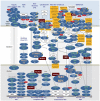Exome sequencing of hepatocellular carcinomas identifies new mutational signatures and potential therapeutic targets
- PMID: 25822088
- PMCID: PMC4587544
- DOI: 10.1038/ng.3252
Exome sequencing of hepatocellular carcinomas identifies new mutational signatures and potential therapeutic targets
Abstract
Genomic analyses promise to improve tumor characterization to optimize personalized treatment for patients with hepatocellular carcinoma (HCC). Exome sequencing analysis of 243 liver tumors identified mutational signatures associated with specific risk factors, mainly combined alcohol and tobacco consumption and exposure to aflatoxin B1. We identified 161 putative driver genes associated with 11 recurrently altered pathways. Associations of mutations defined 3 groups of genes related to risk factors and centered on CTNNB1 (alcohol), TP53 (hepatitis B virus, HBV) and AXIN1. Analyses according to tumor stage progression identified TERT promoter mutation as an early event, whereas FGF3, FGF4, FGF19 or CCND1 amplification and TP53 and CDKN2A alterations appeared at more advanced stages in aggressive tumors. In 28% of the tumors, we identified genetic alterations potentially targetable by US Food and Drug Administration (FDA)-approved drugs. In conclusion, we identified risk factor-specific mutational signatures and defined the extensive landscape of altered genes and pathways in HCC, which will be useful to design clinical trials for targeted therapy.
Figures






Similar articles
-
Cell Culture System for Analysis of Genetic Heterogeneity Within Hepatocellular Carcinomas and Response to Pharmacologic Agents.Gastroenterology. 2017 Jan;152(1):232-242.e4. doi: 10.1053/j.gastro.2016.09.008. Epub 2016 Sep 14. Gastroenterology. 2017. PMID: 27639803
-
Genomic portrait of resectable hepatocellular carcinomas: implications of RB1 and FGF19 aberrations for patient stratification.Hepatology. 2014 Dec;60(6):1972-82. doi: 10.1002/hep.27198. Epub 2014 Sep 22. Hepatology. 2014. PMID: 24798001
-
The apoptotic effect and associated signalling of HSP90 inhibitor 17-DMAG in hepatocellular carcinoma cells.Cell Biol Int. 2012 Oct 1;36(10):893-9. doi: 10.1042/CBI20110473. Cell Biol Int. 2012. PMID: 22694478
-
Mutations in TP53, CTNNB1 and PIK3CA genes in hepatocellular carcinoma associated with hepatitis B and hepatitis C virus infections.Genomics. 2013 Aug;102(2):74-83. doi: 10.1016/j.ygeno.2013.04.001. Epub 2013 Apr 11. Genomics. 2013. PMID: 23583669 Review.
-
Integrative analysis of aberrant Wnt signaling in hepatitis B virus-related hepatocellular carcinoma.World J Gastroenterol. 2015 May 28;21(20):6317-28. doi: 10.3748/wjg.v21.i20.6317. World J Gastroenterol. 2015. PMID: 26034368 Free PMC article. Review.
Cited by
-
Dendritic Cell-Related Gene Signatures in Hepatocellular Carcinoma: An Analysis for Prognosis and Therapy Efficacy Evaluation.J Hepatocell Carcinoma. 2024 Sep 17;11:1743-1761. doi: 10.2147/JHC.S481338. eCollection 2024. J Hepatocell Carcinoma. 2024. PMID: 39309303 Free PMC article.
-
Cancer-Testis Gene Expression in Hepatocellular Carcinoma: Identification of Prognostic Markers and Potential Targets for Immunotherapy.Technol Cancer Res Treat. 2020 Jan-Dec;19:1533033820944274. doi: 10.1177/1533033820944274. Technol Cancer Res Treat. 2020. PMID: 32715976 Free PMC article.
-
Antioxidative Self-Assembling Nanoparticles Attenuate the Development of Steatohepatitis and Inhibit Hepatocarcinogenesis in Mice.Antioxidants (Basel). 2022 Sep 28;11(10):1939. doi: 10.3390/antiox11101939. Antioxidants (Basel). 2022. PMID: 36290662 Free PMC article.
-
The role of RNA modification in hepatocellular carcinoma.Front Pharmacol. 2022 Sep 2;13:984453. doi: 10.3389/fphar.2022.984453. eCollection 2022. Front Pharmacol. 2022. PMID: 36120301 Free PMC article. Review.
-
Revamping Hepatocellular Carcinoma Immunotherapy: The Advent of Microbial Neoantigen Vaccines.Vaccines (Basel). 2024 Aug 21;12(8):930. doi: 10.3390/vaccines12080930. Vaccines (Basel). 2024. PMID: 39204053 Free PMC article. Review.
References
-
- Forner A, Llovet JM, Bruix J. Hepatocellular carcinoma. Lancet. 2012;379:1245–55. - PubMed
-
- El-Serag HB. Hepatocellular carcinoma. N Engl J Med. 2011;365:1118–27. - PubMed
-
- International Consensus Group for Hepatocellular NeoplasiaThe International Consensus Group for Hepatocellular, N. Pathologic diagnosis of early hepatocellular carcinoma: a report of the international consensus group for hepatocellular neoplasia. Hepatology. 2009;49:658–64. - PubMed
-
- Roncalli M, et al. Liver precancerous lesions and hepatocellular carcinoma: the histology report. Dig Liver Dis. 2011;43(Suppl 4):S361–72. - PubMed
-
- Zucman-Rossi J, et al. Genotype-phenotype correlation in hepatocellular adenoma: new classification and relationship with HCC. Hepatology. 2006;43:515–24. - PubMed
References Methods
-
- Waltz RA, Morales JL, Nocedal J, Orban D. An interior algorithm for nonlinear optimization that combines line search and trust region steps. Mathematical Programming. 2006;107:391–408.
Publication types
MeSH terms
Substances
Grants and funding
LinkOut - more resources
Full Text Sources
Other Literature Sources
Medical
Molecular Biology Databases
Research Materials
Miscellaneous

